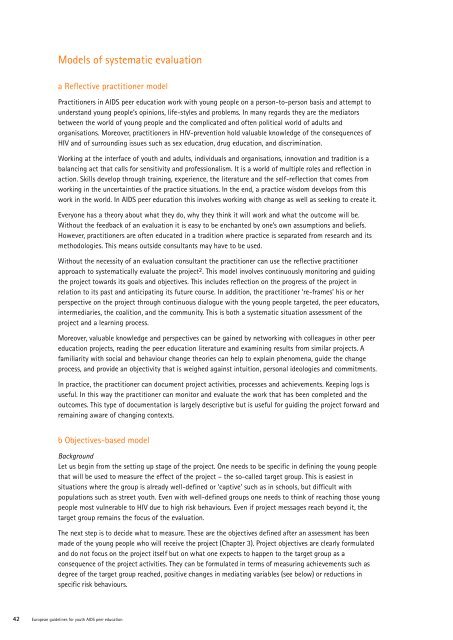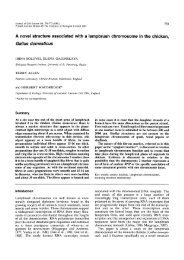European guidelines for youth AIDS peer education - University of ...
European guidelines for youth AIDS peer education - University of ...
European guidelines for youth AIDS peer education - University of ...
- No tags were found...
You also want an ePaper? Increase the reach of your titles
YUMPU automatically turns print PDFs into web optimized ePapers that Google loves.
Models <strong>of</strong> systematic evaluationa Reflective practitioner modelPractitioners in <strong>AIDS</strong> <strong>peer</strong> <strong>education</strong> work with young people on a person-to-person basis and attempt tounderstand young people’s opinions, life-styles and problems. In many regards they are the mediatorsbetween the world <strong>of</strong> young people and the complicated and <strong>of</strong>ten political world <strong>of</strong> adults andorganisations. Moreover, practitioners in HIV-prevention hold valuable knowledge <strong>of</strong> the consequences <strong>of</strong>HIV and <strong>of</strong> surrounding issues such as sex <strong>education</strong>, drug <strong>education</strong>, and discrimination.Working at the interface <strong>of</strong> <strong>youth</strong> and adults, individuals and organisations, innovation and tradition is abalancing act that calls <strong>for</strong> sensitivity and pr<strong>of</strong>essionalism. It is a world <strong>of</strong> multiple roles and reflection inaction. Skills develop through training, experience, the literature and the self-reflection that comes fromworking in the uncertainties <strong>of</strong> the practice situations. In the end, a practice wisdom develops from thiswork in the world. In <strong>AIDS</strong> <strong>peer</strong> <strong>education</strong> this involves working with change as well as seeking to create it.Everyone has a theory about what they do, why they think it will work and what the outcome will be.Without the feedback <strong>of</strong> an evaluation it is easy to be enchanted by one’s own assumptions and beliefs.However, practitioners are <strong>of</strong>ten educated in a tradition where practice is separated from research and itsmethodologies. This means outside consultants may have to be used.Without the necessity <strong>of</strong> an evaluation consultant the practitioner can use the reflective practitionerapproach to systematically evaluate the project 2 . This model involves continuously monitoring and guidingthe project towards its goals and objectives. This includes reflection on the progress <strong>of</strong> the project inrelation to its past and anticipating its future course. In addition, the practitioner ‘re-frames’ his or herperspective on the project through continuous dialogue with the young people targeted, the <strong>peer</strong> educators,intermediaries, the coalition, and the community. This is both a systematic situation assessment <strong>of</strong> theproject and a learning process.Moreover, valuable knowledge and perspectives can be gained by networking with colleagues in other <strong>peer</strong><strong>education</strong> projects, reading the <strong>peer</strong> <strong>education</strong> literature and examining results from similar projects. Afamiliarity with social and behaviour change theories can help to explain phenomena, guide the changeprocess, and provide an objectivity that is weighed against intuition, personal ideologies and commitments.In practice, the practitioner can document project activities, processes and achievements. Keeping logs isuseful. In this way the practitioner can monitor and evaluate the work that has been completed and theoutcomes. This type <strong>of</strong> documentation is largely descriptive but is useful <strong>for</strong> guiding the project <strong>for</strong>ward andremaining aware <strong>of</strong> changing contexts.b Objectives-based modelBackgroundLet us begin from the setting up stage <strong>of</strong> the project. One needs to be specific in defining the young peoplethat will be used to measure the effect <strong>of</strong> the project – the so-called target group. This is easiest insituations where the group is already well-defined or ‘captive’ such as in schools, but difficult withpopulations such as street <strong>youth</strong>. Even with well-defined groups one needs to think <strong>of</strong> reaching those youngpeople most vulnerable to HIV due to high risk behaviours. Even if project messages reach beyond it, thetarget group remains the focus <strong>of</strong> the evaluation.The next step is to decide what to measure. These are the objectives defined after an assessment has beenmade <strong>of</strong> the young people who will receive the project (Chapter 3). Project objectives are clearly <strong>for</strong>mulatedand do not focus on the project itself but on what one expects to happen to the target group as aconsequence <strong>of</strong> the project activities. They can be <strong>for</strong>mulated in terms <strong>of</strong> measuring achievements such asdegree <strong>of</strong> the target group reached, positive changes in mediating variables (see below) or reductions inspecific risk behaviours.42 <strong>European</strong> <strong>guidelines</strong> <strong>for</strong> <strong>youth</strong> <strong>AIDS</strong> <strong>peer</strong> <strong>education</strong>
















